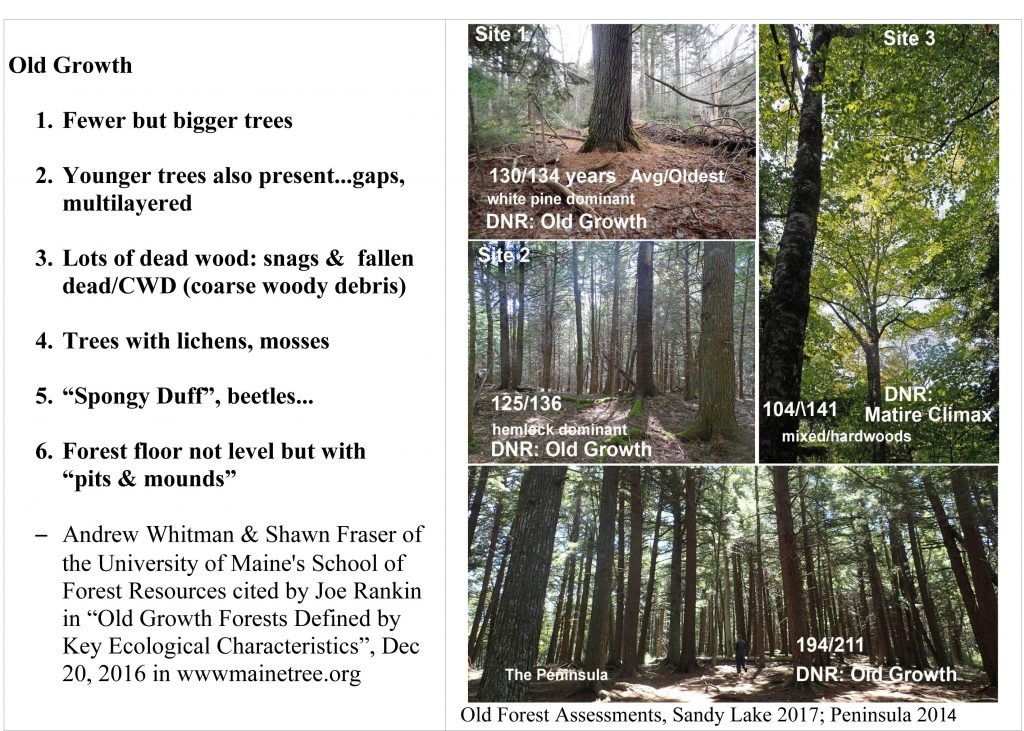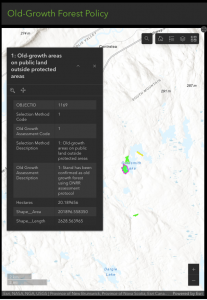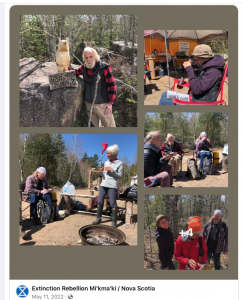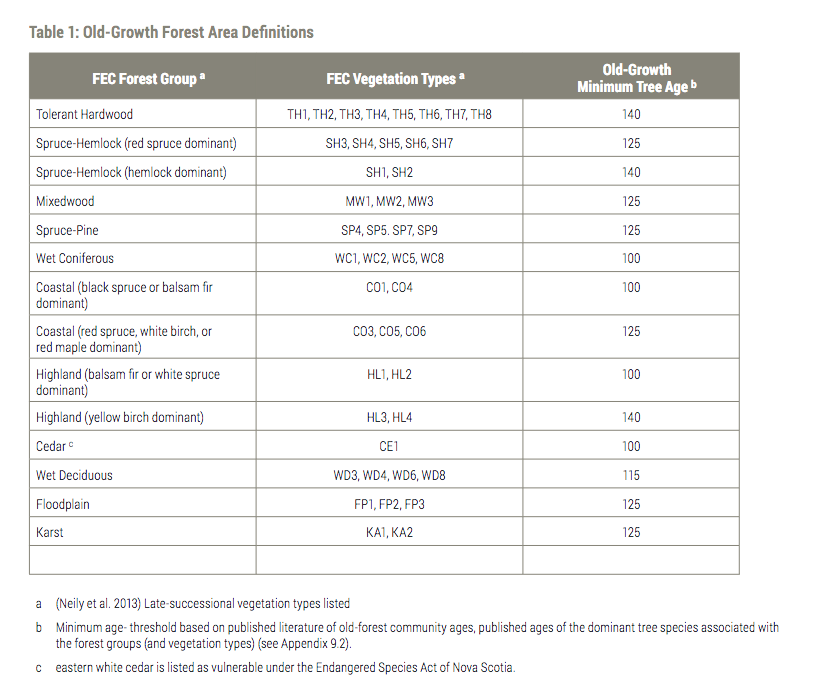From Forest Walk Notes:
D: Patches of Old Growth of 3 types – White Pine dominant, or Hemlock, or Mixed Hardwoods; see graphic in notes/below |
More Info
The answer to “What is Old Growth?” varies according to forest type/location and to how Old Growth is defined for that particular forest type/location. For forests of Eastern north America, Old Growth forests are typically characterized by features 1-6 given above.
Those features do not include age of the trees (or average age), which is the single most important criterion applied to NS forests by our Dept of Natural Resources & Renewables.
Under the first formal definition of Old Growth in NS, given in the NSDNR Old Forest Policy of 2012, Old Growth was defined as
A forest stand where 30% or more of the basal area is in trees 125 years or older, at least half of the basal area is composed of climax species, and total crown closure is a minimum of 30%”.
There was also a requirement, somewhat ambiguously stated, that a whole “stand” as identified by their forest polygon mapping must meet this age requirement; in general that limited Old Growth to areas of at least 2 ha and larger, i.e. smaller “patches” of Old Growth on Crown lands did not meet the criteria and could not be accordingly protected.
While there some criticism of this scheme, it was one of the very few formally defined functional definitions of Old Growth, and received a good review:
Old forest policy and regulatory frameworks in Nova Scotia and New Brunswick with a comparison to British Columbia
Amy Berry, Amanda Lavers and Lisa Mitchell The Forestry Chronicle, 2018, 94(1): 13-19 “…The analysis revealed that in Nova Scotia there is a strong old forest policy underpinned by a quantitative scoresheet, coordinator, and database.”
That policy also provided formal definitions for other forest successional stages, and for “Old Forest”.
In 2022, The Old Forest Policy of 2012 was replaced by a completely revised Old Growth Forest Policy. This policy is much more complicated in regard to age, the minimum average age varying from 100 to 140 years according to the vegetation type, the oldest ages applying to tolerant hardwood stands, the younger ones to some softwood stands.
For policy purposes, operational definitions are required.To address the various types of old-growth forest across the diverse forest regions and site conditions, the Policy uses the provincial forest ecosystem classification focusing on late-successional vegetation types (seeNeily et al., 2013). The old-growth ages have been based on estimates of the minimum age-of-onsetof old-growth attributes (see Appendix A). Because old-growth forest areas are best considered as characterized by relatively little recent human disturbance(Hunter and Schmiegelow, 2011), no forest areas that have received a silvicultural treatment since 1990 will be considered as old-growth forest areas, provided there is documentation of the treatment. An old-growth forest
area, although ideally larger with interior forest, can be considered as small as 1.0 ha (the minimum mapped area in the provincial forest inventory).

NRR-recognized Goldsmith Lake area Old Growth’ see Dashboard
Click on image for larger version
Under both the 2012 policy and the 2022 policy, forests stands on Crown lands in NS that meet the relevant criteria – and are formally documented as such – are “protected” regardless of whether or not they occur in Protected Areas, and are identified in the Old- Growth Forest Policy Layer (example at right)
In practice, applying the age criteria – which requires coring a tree (or cutting it down) – to identify Old Growth on Crown lands limits such ID to forestry professionals or others with the appropriate equipment and experience, and permission of NRR. In any case, coring is an invasive procedure and should not be used willy nilly.
For others (the rest of us), ID of Old Growth can be based on non-age features as cited above, but even if on Crown land, that will not ensure protection; rather one can only report the observations to NRR and wait for them to do a formal assessment to confirm or not that it qualifies for protection.
Nina Newington & Co. have struggled with this issue in their efforts to protect more Old Forest in NS (not just Old Growth) and have come up with another approach which is to identify SAR (Species-at-Risk) lichens in areas of interest.
Sites on Crown lands with such lichens qualify for protection under “At-Risk Lichens–Special Management Practices ” (2018) regardless of whether the sites are in Old Growth stands or not. The protection so applied consists of circular zones of 200 meters (Boreal felt Lichen) or 100 meters (other SAR lichens) around each occurrence in which essentially no commercial activity is permitted; in the case of Boreal felt Lichen the type of harvesting permitted over an additional 300 m is also restricted.

Extinction Rebellion Mi’kma’ki / Nova Scotia
Day 161 at the Last Hope camp
Frances Anderson returned to
teach our second Lichen Identification session. Some of us have definitely got the lichen hunting bug.
Nina Newington & Co. in the course of their protest/camp-out at the Last Hope Camp at Crown land site AP068499 Beals Meadow attracted the interest of lichen enthusiasts; from a post on Extinction Rebellion Mi’kma’ki / Nova Scotia (Public Facebook Page) Jan 26, 2022:
As people have learned about this forest so many people are passionate to protect, lichen enthusiasts have expressed an interest in coming to see for themselves. One did so twice last week. In spite of deep snow, he found three kinds of rare and sensitive lichens growing on oak and maple near the swamps. They are each listed as Species At Risk and require ‘Special Management Practices’ meaning, in this case, no cutting within 100m of each of these kinds of lichen.
To make the story short, that led to some the campers in turn leaning from lichenologists how to ID such species and many more occurrences were identified to the point that 60% of the Last Hope forest was designated completely off-limits to cutting, essentially scotching the entire harvesting plan – see this page on nsforestnotes.ca for some the history.
They are pursing a similar approach at their proposed Goldsmith Lake Wilderness Area – view Lichen Camp GLWA 2024, a wonderfully Nova Scotian initiative.
dp, Apr 22, 2024

